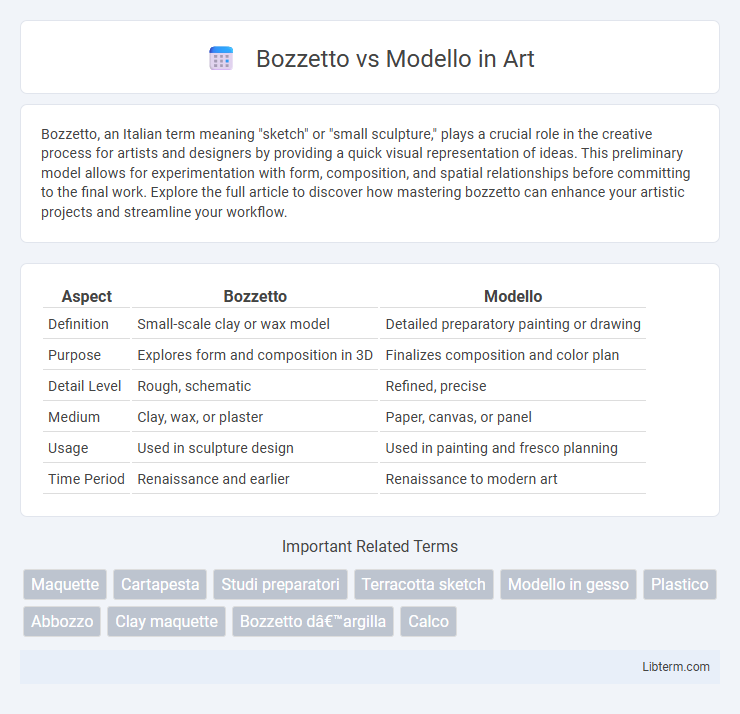Bozzetto, an Italian term meaning "sketch" or "small sculpture," plays a crucial role in the creative process for artists and designers by providing a quick visual representation of ideas. This preliminary model allows for experimentation with form, composition, and spatial relationships before committing to the final work. Explore the full article to discover how mastering bozzetto can enhance your artistic projects and streamline your workflow.
Table of Comparison
| Aspect | Bozzetto | Modello |
|---|---|---|
| Definition | Small-scale clay or wax model | Detailed preparatory painting or drawing |
| Purpose | Explores form and composition in 3D | Finalizes composition and color plan |
| Detail Level | Rough, schematic | Refined, precise |
| Medium | Clay, wax, or plaster | Paper, canvas, or panel |
| Usage | Used in sculpture design | Used in painting and fresco planning |
| Time Period | Renaissance and earlier | Renaissance to modern art |
Introduction to Bozzetto and Modello
Bozzetto and Modello are essential preparatory stages in art and design, often used to visualize ideas before final execution. A bozzetto is a small, rough sketch or maquette that captures the initial concept and explores composition, form, and volume quickly. Modello, by contrast, is a more detailed and refined study, serving as a precise reference for the final artwork or sculpture, often used to gain approval from patrons or collaborators.
Origins and Historical Context
Bozzetto and Modello originated during the Renaissance as preparatory sketches used by artists to visualize and plan complex compositions before executing final works. Bozzetti, typically small and rough, functioned as quick three-dimensional maquettes or sketches to test spatial arrangements, while Modelli were more refined, detailed models or paintings presented for patron approval. These tools reflect the period's evolving emphasis on artistic process, client collaboration, and innovation in composition planning.
Defining Bozzetto: Purpose and Use
Bozzetto, an Italian term meaning "sketch," refers to a small-scale, three-dimensional preliminary model used by artists and designers to visualize composition, form, and spatial relationships before creating a full-scale version. Its primary purpose is to experiment with ideas, proportions, and lighting in a tangible way that allows for quick modifications. This practice is essential in fields such as sculpture, animation, and architecture to refine concepts effectively before investing in detailed execution or production.
Understanding Modello: Characteristics and Function
Modello is a detailed preparatory artwork created to guide the final painting or sculpture and serves as a scaled, refined version of the original concept. It exhibits precise composition, color schemes, and finer details that aid patrons and artists in visualizing the completed work. Unlike the rough and quick Bozzetto, the Modello functions as an essential step in securing approval and planning, reflecting a near-final representation of the intended masterpiece.
Key Differences Between Bozzetto and Modello
Bozzetto is a small-scale, rough sketch or maquette used to explore initial design ideas, emphasizing speed and spontaneity in the creative process. In contrast, Modello refers to a more detailed and refined model or preparatory study that serves as an intermediate step before the final artwork, focusing on composition and color accuracy. The key difference lies in Bozzetto's role as an informal exploratory tool versus Modello's function as a polished, near-final representation.
Artistic Techniques in Bozzetto Creation
Bozzetto creation employs rapid, three-dimensional sculpting techniques to develop preliminary artistic concepts, emphasizing tactile form exploration and spatial relationships. Artists use malleable materials like clay or wax to experiment with volume and composition, facilitating immediate adjustments and creative spontaneity. This hands-on approach contrasts with the more refined, two-dimensional Modello, which serves as a detailed visual plan for final works.
Materials Commonly Used in Modelli
Modelli commonly incorporate materials such as wood, clay, plaster, and wax to create detailed three-dimensional representations in the artistic process. Wood provides a sturdy base, while clay and wax allow for fine manipulation of textures and forms, enabling artists to refine proportions and details before final production. Plaster is frequently used for casting and solidifying shapes, ensuring accurate replication of the intended design in Modelli.
Notable Artists and Their Bozzetti vs Modelli
Notable artists such as Gian Lorenzo Bernini and Michelangelo mastered the use of bozzetti and modelli to plan their large-scale sculptures and frescoes, with bozzetti serving as rough three-dimensional sketches and modelli as more refined, detailed maquettes. Bernini's bozzetti often captured dynamic movement and emotional expression, while his modelli provided precise scale and final composition guidance for projects like the Ecstasy of Saint Teresa. Michelangelo's modelli, particularly for the Sistine Chapel and the Medici Chapel, demonstrate meticulous attention to anatomical accuracy and spatial coherence, elevating the preparatory model from a simple draft to a vital stage in his creative process.
The Role of Bozzetti and Modelli in Art Development
Bozzetti and modelli serve as crucial preparatory stages in the artistic process, with bozzetti functioning as small, three-dimensional sketches that help artists visualize composition and spatial relationships. Modelli, typically two-dimensional detailed models or paintings, refine these initial concepts, allowing artists and patrons to evaluate and approve the design before full-scale execution. The interplay between bozzetti and modelli facilitates iterative development, ensuring accuracy, artistic coherence, and alignment with the intended final artwork.
Contemporary Relevance of Bozzetto and Modello
Bozzetto and Modello remain crucial in contemporary art and design, serving as foundational visual tools for conceptualizing and refining creative projects. Bozzetti function as rapid, small-scale sketches that capture spontaneous ideas, while Modelli offer detailed, polished prototypes pivotal for securing approvals and guiding production. Their ongoing relevance is evident in digital workflows, where these preparatory stages integrate with advanced visualization techniques to enhance communication and innovation.
Bozzetto Infographic

 libterm.com
libterm.com